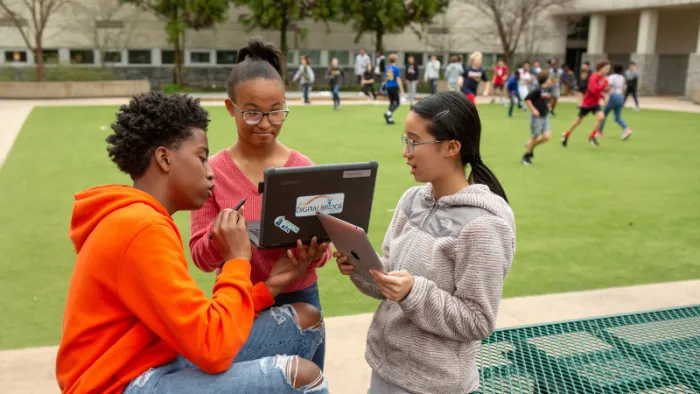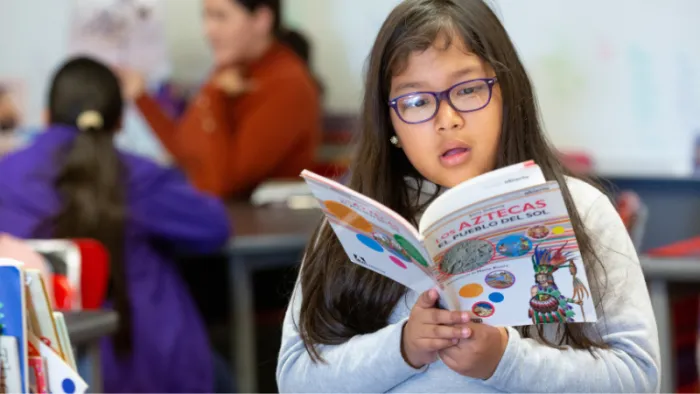Help learners celebrate Black history with these videos, lessons, podcasts, and more.
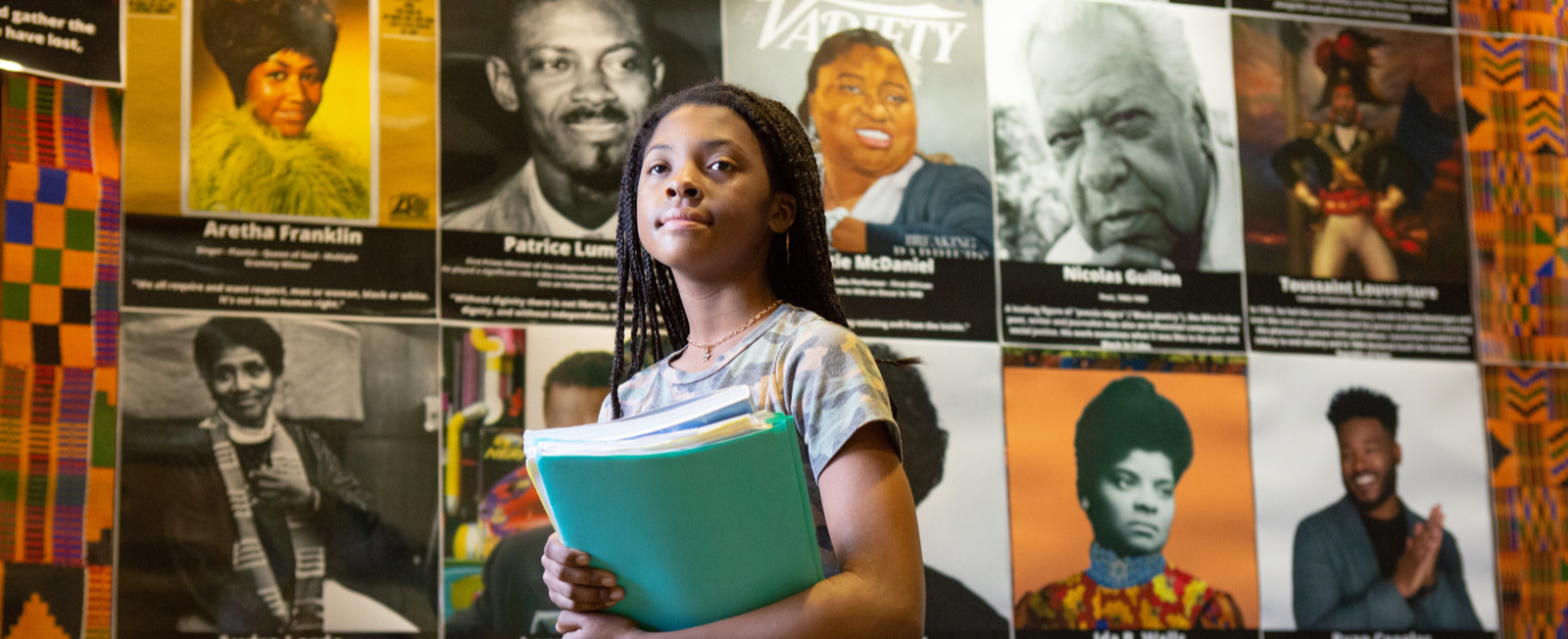
The inclusion of Black history and culture is essential for an accurate and true representation of American (and world) history overall. Black History Month is a time to highlight the people who have not only created foundational innovations, art, and achievements, but also organized and protested for equal rights and freedoms.
Of course, the civil rights movement and figures like Dr. Martin Luther King Jr., Harriet Tubman, and Rosa Parks are integral pieces of this history. But there are lesser-known -- and incredibly impactful -- people and contributions that illustrate an even greater breadth and depth of Black history and culture.
Below you'll find resources -- including videos, texts, lessons, podcasts, and more -- about activists, art and culture, inventors, engineers, historical events, and beyond. And to extend your search even further, don't miss the list of broader collections found at the bottom of this article. Every resource we've curated here has a suggested grade band, but many are flexible and adaptable to just about any age group. Consider the possibilities for how you might integrate these resources into your instruction (or use them at home!) during Black History Month or any time of the year.
A reminder for teachers: Navigate stories and images of oppression and violence with care. Black history is a complicated mix of both triumph and tribulations. While Black history doesn't begin or end with slavery or the injustices of racism, these harsh realities are part of it. Keep in mind your students' abilities when it comes to processing what they're reading, seeing, and listening to, and be aware that triggering topics can sometimes be more traumatic for Black and Brown kids.
Essential Sites and Curricula for All Ages
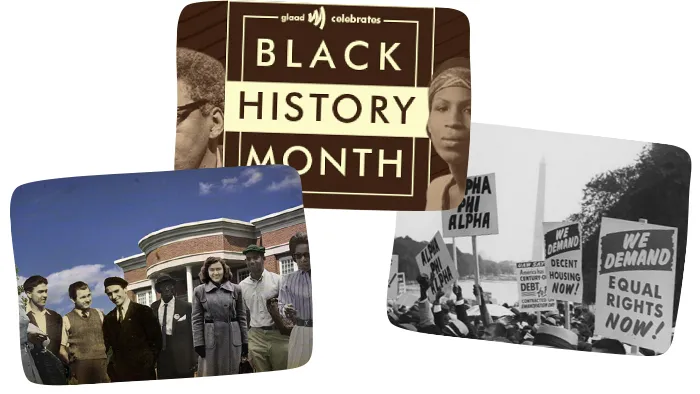
- Browse, select, and read from this great collection of nonfiction and fiction texts written by Black writers, artists, and activists on CommonLit.
- Get lost in this gold mine of in-depth and highly accessible video interviews and biographies of notable African American people on the History Makers website.
- The Center for Racial Justice in Education has a guide for educators that hosts a huge collection of lessons and resources.
- Smithsonian's History Explorer has a ton of activities labeled with the appropriate grade band and including interactives and artifacts.
- MAEC has collected lists of podcasts, articles, books, and more that span several grade levels.
- The Library of Congress has some great resources that can help you dig deeper into familiar topics to find primary sources and more.
- Hear from Black authors on the Reading Rockets site to learn about their processes and perspectives.
- Check out the lesson plans (by grade band) hosted by the NEA that include printables, activities, and more.
Activities and Resources for Preschool to Third Grade
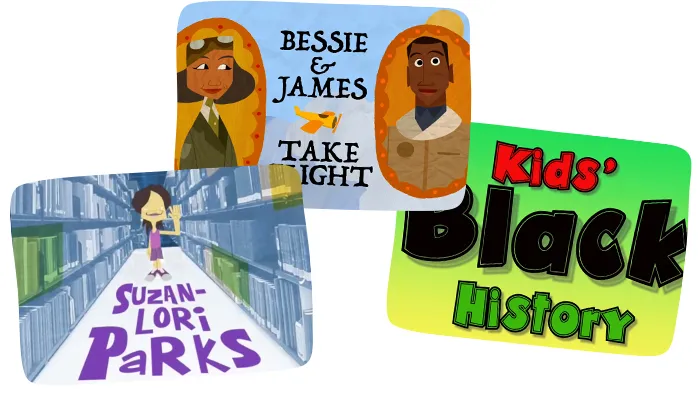
Audio and Stories for Preschool to Third Grade
- Listen along as James Earl Jones reads "To Be a Drum," a story of rhythm, history, and freedom.
- Enjoy the African Folktales With Miss Jo Jo podcast to hear stories that originated in Africa and were passed down through generations.
Videos for Preschool to Third Grade
- Let this mother-daughter team, the hosts of Kids Black History on YouTube, teach some facts about Africa in a video that's sure to make you smile. (Grades pre-K-1)
- Watch this YouTube video from Nickelodeon to find out how Suzan-Lori Parks became the first African American woman to win the Pulitzer Prize for writing dramatic plays.
- Learn about the first Black pilots in this YouTube video from Sesame Studios. What would it be like to build and fly your own plane?
- Find out about the inventor of the modern traffic light and what else he created in this YouTube video from Kids Black History.
- Check out Craig Thompson's alphabet of amazing Black inventors to revisit some who are familiar and discover others you didn't know.
- This YouTube video from Nickelodeon highlights the brilliant and driven Alexa Canady, the first Black woman to become a neurosurgeon in 1981.
Hands-On Activities for Preschool to Third Grade
- Follow along with this YouTube video and use your body to play the Hambone -- an African drumming technique with historical significance.
- Try this George Washington Carver-inspired craft that just requires a paper plate, paper, and some paint!
Activities and Resources for Third to Fifth Grade
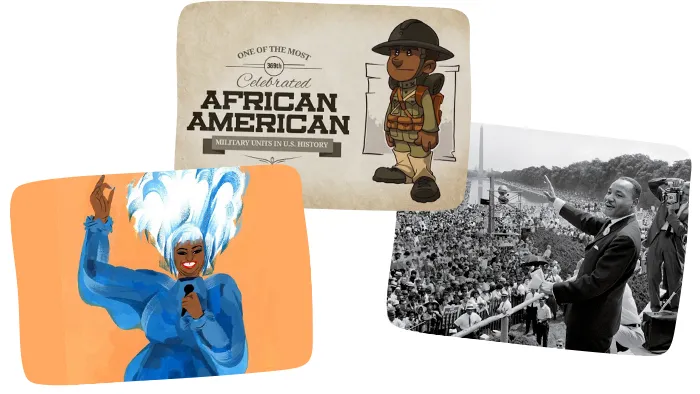
Audio and Stories for Third Grade to Fifth Grade
- Listen to this episode from The Past and the Curious podcast about blues and folk musician Elizabeth Cotten, whose catchy songs traveled all over the world and even influenced the Beatles.
- Journey into the world of Latin American music with this podcast episode (via YouTube) from Good Night Stories for Rebel Girls and learn about the life of Celia Cruz, the Cuban Afro-Latina singer known as the Queen of Salsa.
- Hey Black Child: The Podcast features lesser-known African American Heroes and is hosted by kids!
Videos for Third Grade to Fifth Grade
- Find out about the African American inventor Lewis Latimer, who contributed to the creation of the light bulb, telephone, and more in this YouTube video from the Fab Lab.
- Check out this video and article on Dorothy Vaughan, the supervisor of a group of boundary-breaking African American women whose calculations got astronauts into space.
- Through this Smithsonian video and article, get a feel for the sounds and movements, and a sense of the rich history, behind Afro-Peruvian music, a unique result of the African diaspora.
- Let Flocabulary introduce George Washington Carver's life, the challenges he faced, and his accomplishments as an inventor and innovator. Then, ask students to consider how his ideas changed life for us all today.
- From The Kid Should See This, learn about science educator and graduate student Adania Flemming, who studies marine life at the University of Florida. Or discover the trailblazing accomplishments of Matthew Henson, who broke boundaries as an Arctic explorer and African American.
- Listen as the kids from Global Citizen share what they know about Black history.
Hands-On Activities for Third Grade to Fifth Grade
- Using this lesson (via Google Slides) from the New York Historical Society, delve into the extraordinary life, achievements, and art of sculptor and gallerist Augusta Savage, who was a key part of the Harlem Renaissance.
- Explore the influential history of African drumming using this video from the Kennedy Center, and try out some of the key techniques. Feel free to also click through and watch the other videos.
- Practice some simple and fun moves from traditional West African dance as you watch this YouTube video from the Lincoln Center.
Text-Based Activities for Third Grade to Fifth Grade
- Read about the March on Washington for Jobs and Freedom in 1963 and Dr. Martin Luther King Jr.'s famous "I Have a Dream" speech in this piece by Time for Kids.
- Learn about Wangari Maathai's environmental and political activism, which resulted in a Nobel Prize -- the first for an African woman -- with this article from Britannica Kids.
- From NASA, you can find out about Katherine Johnson, another of the mathematicians whose calculations got us to the moon and back.
- This book list might have some selections to entice your students to learn about Black history.
Activities and Resources for Sixth to Eighth Grade
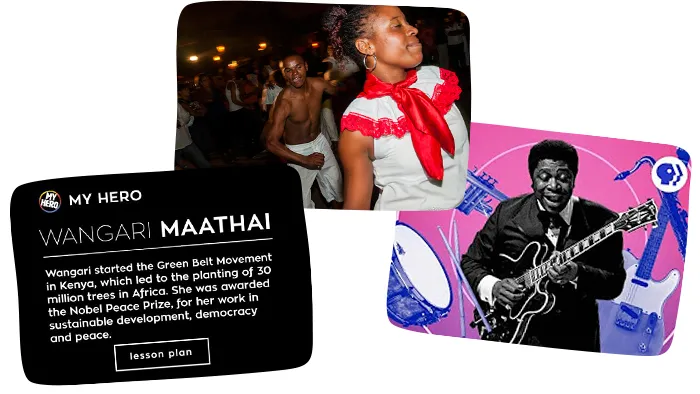
Audio and Stories for Sixth Grade to Eighth Grade
- Listen to this episode of The Past and the Curious to learn about Jerry Lawson, who had a hand in inventing modern video games!
- Through this episode of The Stuff You Missed in History Class, you can find out about the Preliminary Emancipation Proclamation.
Videos for Sixth Grade to Eighth Grade
- View rare film footage of daily work, play, school celebrations, gatherings, and sporting events in the all-Black towns of 1920s Oklahoma, from National Geographic's YouTube channel.
- Travel back to the late 16th century with the Heroes of Color channel on YouTube to learn about Gaspar Yanga and one of the earliest rebellions of enslaved people in the Americas. Or learn about the heroic achievements of the 369th Infantry Regiment, an all-Black unit that fought for the U.S. during World Wars I and II.
- Use this video from the YouTube channel Black History in Two Minutes to teach students about Shirley Chisholm, the first Black congresswoman and a champion for civil rights.
- Watch this video from NBC News Learn's YouTube channel to follow the extraordinary and complex life of Marcus Garvey, whose vision of a pan-African movement continues to influence Black thinkers and culture today.
- Sit down with jazz musician Robert Glasper, featured in this YouTube video from Jazz Night in America, as he shows the jazz origins of famous hip-hop samples and tracks.
- Learn more about the extensive influence of the blues and its roots in Black history from this YouTube video by PBS's Sound Field.
- Using this video from PBS, explore the origins, traditions, and influence of gospel music, created and celebrated weekly in Black churches across the country.
- Be moved by the 400-year-old history of bomba, a style of music and dance created by enslaved people who resisted colonial culture, in this YouTube video from PBS.
Hands-On Activities for Sixth Grade to Eighth Grade
- Visit this online exhibition from the Gilder Lehrman Institute of American History to read about Frederick Douglass and see images of some of his handwritten documents.
- Learn more about the history behind trap music, a ubiquitous, influential music genre, in this lesson from PBS LearningMedia.
- Watch this video from Flocabulary to examine Langston Hughes' most famous poem and his use of figurative language. Then have students write their own "Harlem"-inspired poem.
- Read one of the many thought-provoking stories on the National Museum of African American History and Culture (NMAAHC) website, and then dig into the associated collections of artifacts.
Text-Based Activities for Sixth Grade to Eighth Grade
- Learn about Wangari Maathai's environmental and political activism, which resulted in a Nobel Prize -- the first for an African woman -- in this article about her life story on the Wangari Maathai Foundation's website.
- Read this article from Smithsonian Magazine on the history of African American Cowboys, then have students compare this with how cowboys are portrayed in Hollywood and other pop-culture entertainment.
- These hand-selected book picks include lots of reading levels and interests, from historical events to popular figures.
Activities and Resources for Ninth to Twelfth Grade
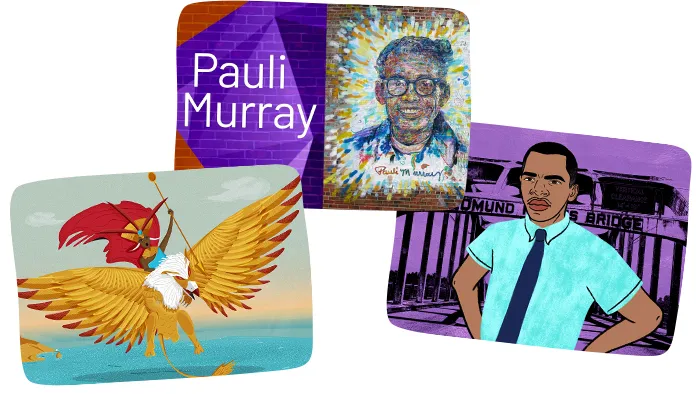
Audio and Stories for Ninth to Twelfth Grade
- This episode of The Stuff You Missed in History Class begins with a murder in Pennsylvania, but goes on to highlight the racial injustice apparent during post-Reconstruction.
- And this episode highlights the Harlem Hellfighters, a highly decorated Black Army unit who fought in WWI.
Videos for Ninth to Twelfth Grade
- Use this collection of videos from NBC News to augment what kids might already know about MLK's legacy and movement.
- Watch a short video from TEDEd about civil rights activist Rosa Parks that digs into some information kids might not already know. Then use some of the comprehension questions or additional resources to extend students' learning.
- Watch Flocabulary's introduction to John Lewis' life, activism, and influence on generations of others, featuring lyrics written by a ninth grader. Afterward, have students choose an event mentioned in the video and research it further.
- From 60 Minutes, watch this famous exchange between MLK and journalist Mike Wallace. Ask students: What does King mean by "riots are the language of the unheard"?
- Watch this video about Jesse Owens and the 1936 Olympics. Then use the discussion questions and worksheet to consider the role of protest in sports today.
- Using this Retro Report video and text, learn about how Black women have had to fight to win and maintain their voting right.
- Check out this video and article from Unladylike2020 to learn about the talented opera singer Sissieretta Jones, the first African American woman to headline at Carnegie Hall. Warning: Contains graphic content. While you're there, learn about Meta Warrick Fuller, the first African American woman recipient of a federal art commission, who was nicknamed "the sculptor of horrors" for her dark, expressive creations. Or discover the singular life and style of Gladys Bentley, a Harlem Renaissance artist whose bold performances challenged gender roles and norms.
- Use this animated video from TEDEd as an introduction to James Baldwin, the influential writer who was stalked by the FBI for championing civil rights and social justice.
- Watch Chris Rock's documentary Good Hair (free on Kanopy), which explores the societal and cultural ideas behind Black people's hair.
- Join hip-hop artist Nas via Poetry in America as he discusses his song "N.Y. State of Mind" and considers hip-hop’s place in the poetic canon. Note: Includes mature content.
- Discover the origins of breakdancing and learn about its far-reaching influence in this short documentary-style video from Vox.
- From Art21, step into the world of Kevin Beasley's art through this YouTube video, which explores his historical inspiration and reckons with the brutal legacy of slavery. Or experience the stunning and provocative contemporary art and performance of Abigail DeVille, whose work takes a critical look at history.
- Via Crash Course on YouTube, delve into the extraordinary and inspiring history of the Haitian revolution, which saw enslaved people liberate themselves, overthrow colonial rule, and create their own country.
- Dig deeper into some lesser-known history of the Black Panthers with this YouTube video from AJ+, and discover their history of community outreach and health care support, grounded in compassion and self-reliance.
- Join two art historians in this YouTube video from Khan Academy as they discuss this important series of paintings about African Americans migrating north in search of work and new lives.
- See how Mexican people with African ancestry reconnect with their roots through dance and performance in this YouTube video from AJ+.
Hands-On Activities for Ninth to Twelfth Grade
- Learn about Wangari Maathai's environmental and political activism, which resulted in a Nobel Prize -- the first for an African woman -- with this lesson plan from the My Hero website.
- Teach this lesson from PBS LearningMedia about the accomplishments of civil rights activist, lawyer, author, and priest Pauli Murray, who stood against the many forms of injustice.
- Use this PBS LearningMedia lesson to learn about the life of Alain Locke, a gay philosopher whose work set the stage for the Harlem Renaissance.
- Use this site from American Ancestors and the GU272 Memory Project to research and learn about the enslaved people who were sold to raise money to build Georgetown University, and hear their ancestors' stories as well.
- Learn about the life of activist Marsha P. Johnson, who helped spark the Pride movement and a fight for LGBTQ+ rights that continues today. Use this lesson from PBS LearningMedia as-is, or adapt it to fit your needs.
Text-Based Activities for Ninth to Twelfth Grade
- Read this Atlas Obscura article to learn the story of the mythical 16th-century Black queen Calafia, for whom California is named.
- Honor the bravery of Elizabeth Jennings by reading this Atlas Obscura narrative about her historic stand against segregation in 19th-century New York, long before the famous bus boycott in 1955.
- Read Malcolm X's famous "The Ballot or the Bullet" speech and this Teen Vogue article reflecting on its legacy.
- Read this article from IGN about inventor and engineer Jerry Lawson, who developed the first interchangeable, cartridge-based video game system -- before Atari and Nintendo!
- Learn how Afro-Latino baseball Hall of Famer Roberto Clemente changed hearts and minds during the civil rights movement. Use the included PBS LearningMedia student guide for supplemental activities.
- Find out about the accomplishments of eight extraordinary Afro-Latino people. From artists to activists, each person contributed to the legacy of the African diaspora.
- Share this article from History.com, or this one from the Washington Post, to help students discover the amazing story of Bass Reeves, one of the first Black U.S. marshals west of the Mississippi, and probable inspiration for the American pop-culture icon the Lone Ranger.








